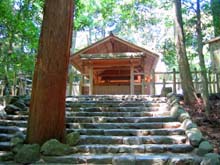| |
|
 |
What do Shintos believe?
 |
 |
 |
Steps leading to one of the shrines at Ise, Japan’s most important centre of worship |
Shinto mythology
Early Japanese myths emphasise harmony with nature and maintaining the balance between the human and natural world. The most popular deity in Japan is the Goddess Amaterasu, the Sun Goddess. She is protector of Japan and is worshipped at Ise, the most important shrine in Japan. From her are descended all the gods, the emperor and the Japanese people.
The divine state
Within Japanese myths are found nature spirits, noble heroes, and ancestral deities, both male and female. From the epic dramas woven around those deities, the Japanese people have learned how to live. In Shinto, human beings are believed to be born pure, with a gentle and clear disposition. To be pure is to approach godliness; indeed it is to become one with the state of the divine. It is Shinto's prayer, Shinto's heart, to return to that original human state, and live a daily life which is at one with the kami, indigenous folk deities of Japan.
Shinto shrines and festivals
Shinto shrines are regarded as the spiritual home of the Japanese. They are dedicated to the kami. A Shintu shrines is usually within a sacred grove, as reverence for Nature forms an important part of the Shinto tradition. The shrine is approached through a gateway called a torii, signifying entrance to a sacred space. Festivals to honour the folk deities, called ‘matsuri’, take place at the shrines, involving young and old.
|
 |
|
|
|
|
|
 |
The Seven-Year Plan: Use of Assets
The religions of the world have astonishing assets - as well as their outreach to 85 percent or more of the world's 8 billion people, they also own some five percent of forests, are connected to more than half of all schools, own and manage most of the world's tourist destinations, organise some of the most active tourism enterprises (in terms of pilgrimage) and control some 7 percent of all financial investments. |
 |
Shinto Forestry
It is the forests, and not the buildings, that mark the true shrines of Shintoism. The deities are invited to these forests, where they and their environment are protected by the local community, which in turn is protected by the deities. |
 |
 |
|
|

